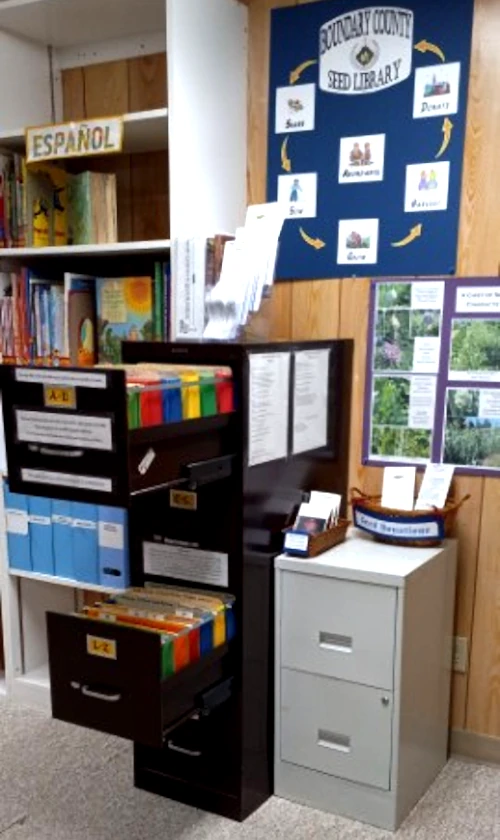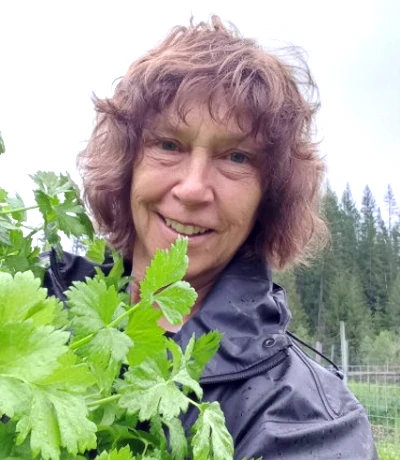 In addition to books, periodicals, videos, magazines and all its other resources, the Boundary County Library is now hosting a Boundary County Seed Library offering county gardeners free seeds acclimate specifically to our region as well as information on how to share seeds to keep the library going and growing.
In addition to books, periodicals, videos, magazines and all its other resources, the Boundary County Library is now hosting a Boundary County Seed Library offering county gardeners free seeds acclimate specifically to our region as well as information on how to share seeds to keep the library going and growing.
The first seed library was started in 2004 in Gardiner, New York, the brain child of Ken Greene. Our modest library joins a growing number of over 800 seed libraries across the country.
It was started in February by Jody McClintock, long time local resident and seed saver. The idea of the library was a natural progression.
“I started sharing my extra seeds with neighbors and at casual seed exchanges with other gardeners,” Jody said. “For a while I also contributed to the local seed bank at the Extension Office. Some of the abundance was shared with grass roots seed companies, but I wanted to keep it local. I noticed the same 20 people or so would show up every year for the seed swaps, which was great, but I thought how do I share this amazing resource with more people? I have a root cellar with jars of seed, more than I can possibly use, even considering the shelf life of the different varieties, hence the idea of the seed library sprouted.”
She spoke with library director Lynn Starr, who loved the idea, and thought it would be a good fit for our community. What better way to promote the learning of seed saving then at your local library?
Jody went through he inventory and began packaging seed. She was confident of the seed viability but did germination testing when she wanted to double check the rates.
In the end, she was able to offer 33 varieties of vegetables and a handful of flower varieties, a grand total of 1,456 packets. Being a detail-oriented person, she included seed saving instructions on the packaging when possible, even though space id limited on a 3×4-inch package.”
The seed library is located in two file cabinets in the basement of the library. Because of limited inventory you are allowed to take as many varieties as you need, but only one packet per variety to allow the seed to be shared with as many people as possible. There is more than enough seed included in packages to grow a crop, as well as grow seed.
The idea of a seed library is to grow enough for food for yourself as well as seed, so that at the end of the season you can donate a portion of the seed back to the library.
Donating seed back is optional, not a requirement for obtaining seed. Not everyone has the space or know-how for seed saving, but if you are interested in learning how to save seed, the library offers excellent reference books for seed saving and there are two books on top of the seed library cabinets for you to view. If there is enough interest the Extension Office may offer seed-saving classes.
To ensure healthy seed that is true to type, there are guide lines listed in the brochure, “How to Donate Seed” and a donation form to fill out and submit with your seeds. There is also a brochure called “Seed Saving Hints” that has excellent information about seed saving and what is required in growing the seed for donation.
If you donate seed, there are empty seed packets available.

Seed bank managers are out growing crops and don’t have the time or volunteers to package bulk seed, so they ask that you go the extra mile and package your own donations, then place them in the donation basket on the file cabinet along with the donation form.
There are several reasons for starting this seed library that go beyond free seed. Sustainability, community enrichment, local self-sufficiency and resilience to begin with a few.
Four multi-national seed companies control 60-percent of the commercial seed sales.
As a result of this, smaller regional seed companies similar to our growing region have disappeared taking their unique varieties with them, in exchange for higher and higher seed pricing. A lot of catalogs offer more hybrids then open-pollinated varieties ensuring repeat customers, as a hybrid will not come back true to type.
In the seed library the “seed” is the real champion of this story.
A plant that has grown in the same microclimate year after year goes through a miraculous transformation. It adapts. It learns to tolerate our cold nights and blistering days (new to our region).
They develop a resistance to insects and disease, and stresses unique to our area. This is also aided by growing a large enough population to capture all these genetic traits. The basic rule is that seed should be saved from 24 inbreeding plants or 100 out breeding plants.
Plants pass learned knowledge and traits down to the next generation via their seed. If the sampling of seed that was collected is too small, you lose the advantage of all this “learned knowledge.” Strength is in numbers; resilience exists across a spectrum.
It’s as if one must live in the area for a while, put down deep roots and experience a few seasons before going native and becoming local.
Speaking of local, two more local seed savers have donated regionally grown seed to the library. A great many of the seeds offered have been grown for years in very tough conditions and weird microclimates yet they thrive. They are tried and true varieties that ripen and produce abundant yields.
This is too great a treasure to ignore.
All are encouraged to come in and help yourself to the seed offered, grow a crop, get to know the plant. Learning how to save the seed can come later if you don’t already know how.
The end game is to have a community of dedicated seed savers. If many contribute, then the work load is distributed. There is a more diverse growing region added to the mix. If I have a crop failure and no back up seed, you might have a bumper crop and may share the bounty.
Opportunities are increased for diversity. But above all else, Boundary County has access to its very own seed source, grown and adapted to our local region, independent of an outside source.
We grow it, we own it.
